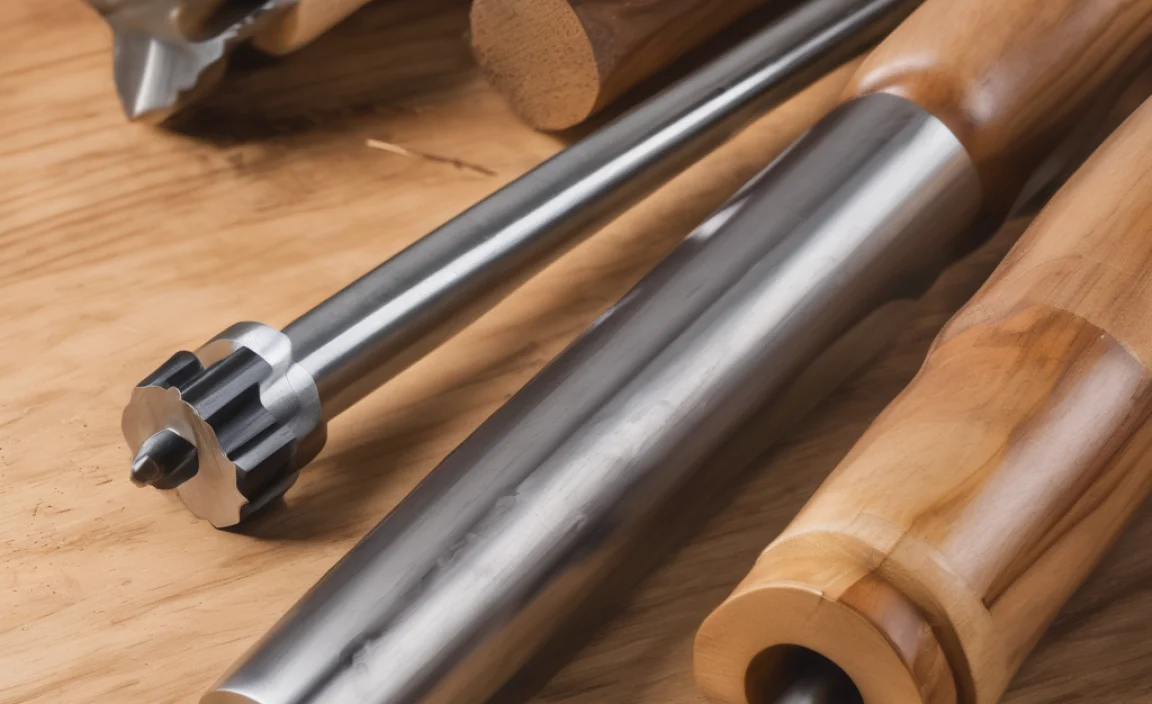Quick Summary: For fast, clean aluminum MRR (Material Removal Rate) with a 1/8″ carbide end mill, using a 4-flute, uncoated, stub-length tool designed for aluminum is a proven choice. Optimize by running it at moderate speeds and feeds, ensuring ample coolant, and understanding your machine’s rigidity. This combination delivers excellent results for hobbyists and pros alike.
Hey there, fellow makers and machinists! Daniel Bates here from Lathe Hub. Ever found yourself staring at a piece of aluminum, wondering if that tiny 1/8″ end mill could really chew through it efficiently? You’re not alone. Many beginners (and even some seasoned folks!) struggle with getting the best performance when machining aluminum, especially with smaller tools. It can be frustrating to see slow progress or end up with a messy, galled-up workpiece. But don’t worry! Today, we’re going to dive deep into the world of the 1/8″ carbide end mill, specifically how to make it a powerhouse for your aluminum machining projects. We’ll cover everything you need to know to get those fast, clean cuts you’re after. Get ready to boost your MRR!
Choosing the Right 1/8″ Carbide End Mill for Aluminum MRR
So, you’ve decided to tackle some aluminum with your CNC machine or manual mill, and you’re looking at that 1/8″ end mill. What makes one “proven” for “MRR” (Material Removal Rate) in aluminum compared to another? It boils down to a few key features designed to work together perfectly. When we talk about high MRR in aluminum, we mean removing material quickly and efficiently. For a small tool like a 1/8″ end mill, this requires a specific design.
The Anatomy of an Ideal Aluminum End Mill
Let’s break down the crucial characteristics of a carbide end mill that excels in aluminum:
- Material: Solid Carbide. This is non-negotiable for aluminum machining. Carbide’s hardness and heat resistance allow it to cut much faster than High-Speed Steel (HSS). For aluminum, we’re looking for a fine-grain carbide for toughness and edge retention.
- Number of Flutes: 4 Flutes (Typically). While 2-flute end mills are great for slotting and clearing chips, a 4-flute end mill often offers a better balance for general-purpose aluminum machining. It provides more cutting edges for a smoother finish and can handle higher feed rates in the middle of a cut. However, for very deep slots or aggressive slotting where chip evacuation is paramount, a 2-flute might still be preferred. For MRR in general milling operations in aluminum, 4 flutes are usually the sweet spot.
- Coating: Uncoated or Specialized Aluminum Coatings. For aluminum, “uncoated” carbide is often the best choice. Aluminum tends to stick to coatings like TiN (Titanium Nitride) or TiAlN (Titanium Aluminum Nitride), leading to galling and poor surface finish. If a coating is used, look for specialized coatings designed for aluminum (like ZrN – Zirconium Nitride, or AlTiB – Aluminum Titanium Boride), which have low friction properties. However, for simplicity and often excellent results, uncoated is a safe and effective bet.
- Helix Angle: High Helix (30-45 Degrees). A higher helix angle provides a shearing action as the flutes engage the material. This results in a smoother cut, lower cutting forces, and better chip evacuation, all of which contribute to higher MRR and a better finish in sticky materials like aluminum.
- End Shape: Square or Slight Corner Radius. For general MRR, a square end is common. A small corner radius (e.g., 0.010″ to 0.030″ on a 1/8″ tool) can add strength to the cutting edge, preventing chipping, and slightly improve surface finish by reducing stress concentration at the corners. For pure roughing and maximum material removal, a sharp square corner is ideal, but it’s also more prone to chipping.
- Length: Stub or Standard Length. For aluminum MRR, especially in hobbyist machines that might have less rigidity, a “stub” length end mill is often highly recommended. These are shorter than standard length end mills, meaning less tool deflection under cutting forces. Less deflection equals a more accurate cut and the ability to push the tool a little harder, increasing MRR. A 1/8″ stub length end mill typically has a total length of 1.5 to 2 inches, with about 0.5 inches of cutting length.
- Clearance: Good Undercut and Neck Relief. Adequate clearance behind the cutting edges (especially in the flute gullets) is critical for efficient chip removal. Aluminum chips can be long and stringy, and efficient evacuation prevents them from re-cutting or packing up, which is essential for high MRR and preventing tool breakage.
Why “Stub Length” Matters for 1/8″ Aluminum MRR
When we talk about a 1/8″ end mill, that small diameter is already limited. The primary factor that most limits cutting performance is tool deflection. A longer tool will flex more than a shorter tool under the same cutting load. A stub length end mill significantly reduces this lever arm, making the tool much more rigid. For aluminum, which can sometimes “push back” unexpectedly, this rigidity is key to maintaining your cutting parameters and achieving high MRR without sacrificing finish or risking tool breakage.
Consider the forces: imagine trying to push a long, thin stick through a piece of wood versus a short, thick one. The short one is much easier to control and you can apply more force before it bends significantly. The same principle applies to end mills. A stub length carbide end mill 1/8 inch 1/4 shank stub length for aluminum 6061 high mrr will outperform its longer counterparts in terms of rigidity and the ability to maintain cutting parameters for effective material removal.
Understanding Aluminum Alloys for Machining
Not all aluminum is created equal! The specific alloy has a significant impact on how it machines. For hobbyists and general fabrication, 6061 aluminum is incredibly common. It’s an excellent all-around alloy known for its good strength, weldability, and excellent corrosion resistance after heat treatment. It’s also relatively easy to machine compared to some other aluminum alloys.
When we talk about machining 6061 aluminum, it’s known for being a bit “gummy” or “sticky.” This means it can easily adhere to the cutting tool, leading to buildup (galling) on the flutes. This is precisely why the tool geometry and coatings mentioned earlier are so important. A tool designed for aluminum fights this stickiness.
Other common aluminum alloys you might encounter include:
- 1100, 1050, 1060: These are commercially pure aluminums. Very soft and ductile, they can be gummy and tend to gall easily. They require very sharp tools and careful feed rates.
- 3003: Similar to the 1xxx series but with manganese added for moderate strength. Still quite gummy.
- 5052: A very popular alloy, stronger than the 3xxx series, with good corrosion and weldability. It’s a bit harder than 6061 and can sometimes be more prone to work hardening.
- 7075: A high-strength alloy, often used in aerospace. It’s harder and more abrasive than 6061 and requires more robust tooling and setups. High MRR here requires more power and rigidity.
For the purposes of this guide, we’re focusing on 6061 as it’s the most common alloy that beginners will encounter, and the recommended tooling will serve you very well with it. If you’re venturing into harder or softer aluminums, you might need to adjust speeds and feeds, but the fundamental principles of tool selection remain the same.
Setting Up Your Machine for High MRR
Even with the perfect tool, your machine setup is critical for achieving high MRR, especially with a small 1/8″ end mill. Rigidity is king!
Machine Rigidity and Workholding
- Machine Stability: Is your machine sturdy? A wobbly mill will chatter, deflect, and prevent you from taking aggressive cuts. Ensure your machine is on a solid base and that all gibs are properly adjusted.
- Tool Holder Rigidity: A good quality collet chuck or end mill holder is essential. Avoid set-screw style holders if possible, especially for aluminum, as they can introduce runout and vibration. A high-precision ER collet chuck is a great investment for small tools. Ensure the collet is clean and properly seated.
- Workholding: Your workpiece needs to be clamped down securely. For aluminum, a vise is common. Use soft jaws if you’re concerned about marring the surface, but ensure the vise jaws have good contact and are tight. As you cut, aluminum chips can sometimes get under the clamps, so periodically check that your part hasn’t shifted. If you’re doing deep cuts, consider additional support or fixturing.
Coolant and Lubrication
Aluminum is notorious for its tendency to weld itself to the cutting edge. This is where coolant or lubrication becomes vital, even for drilling and milling. For high MRR in aluminum, using a lubricant is highly recommended.
- Flood Coolant: The most effective. A steady stream of coolant washes away chips, cools the cutting zone, and lubricates the cut. This is what professional shops use for high-speed machining.
- Mist Coolant/Lubrication: A good compromise for hobbyist machines that aren’t equipped for flood coolant. A fine mist of coolant or a specialized cutting fluid applied during the cut can significantly reduce friction and chip welding.
- Cutting Fluid/Paste: For very light duty or specific operations, applicator sticks or bottles of cutting fluid can help. Apply directly to the cutting tool or the workpiece just before or during the cut. When machining aluminum, look for fluids specifically formulated to prevent chip welding.
For high MRR in aluminum with a 1/8″ end mill, a flood or mist system is ideal. If you don’t have either, applying a high-quality aluminum-specific cutting fluid generously as you machine will make a noticeable difference in performance and tool life.
Optimal Speeds and Feeds for 1/8″ Aluminum End Mills
This is where things get interesting and where you can really dial in your MRR. Speeds and feeds depend on many factors: the machine, the rigidity, the coolant, the specific aluminum alloy, and the end mill itself. However, we can provide excellent starting points for a 1/8″ 4-flute carbide end mill in 6061 aluminum.
Understanding Surface Speed (SFM) and Chip Load
- Surface Speed (SFM – Surface Feet per Minute): This is the speed of the material passing over the cutting edge. For carbide on aluminum, a common range is 300-800 SFM. Let’s aim for the middle to upper end for good MRR.
- Chip Load (IPT – Inches per Tooth): This is how much material each cutting flute removes per revolution. This is critical for preventing chip welding and ensuring efficient cutting. For a 1/8″ end mill in aluminum, a good starting point is often around 0.0010″ to 0.0025″ IPT.
Calculating Spindle Speed (RPM)
The formula to calculate spindle speed (RPM) is:
RPM = (SFM 12) / (π Diameter)
Where:
- SFM = Desired Surface Feet per Minute
- 12 = Inches per Foot
- π (Pi) = 3.14159
- Diameter = Diameter of the end mill in inches
Let’s calculate for a target SFM of 500 SFM:
RPM = (500 12) / (3.14159 0.125)
RPM = 6000 / 0.3927
RPM ≈ 15,279 RPM
This RPM is quite high for many desktop or smaller benchtop CNC machines. This highlights a common challenge with small diameter tools: achieving optimal surface speeds often requires high RPMs. For machines limited to lower RPMs (e.g., 10,000 RPM or less), you’ll need to accept a lower SFM and focus on optimizing the chip load.
Calculating Feed Rate (IPM)
Once you have your RPM and desired chip load, you can calculate the feed rate (IPM – Inches per Minute):
IPM = RPM Number of Flutes Chip Load
Scenario 1: High RPM Machine (e.g., 20,000 RPM spindle with a good collet)
Let’s use a robust chip load of 0.002″ IPT:
IPM = 20,000 RPM 4 Flutes 0.002" IPT
IPM = 160 IPM
This would be a very aggressive feed rate for a 1/8″ end mill, pushing for high MRR. You’d need a very rigid setup and excellent coolant for this.
Scenario 2: More Common Hobbyist Machine (e.g., 10,000 RPM spindle)
If your machine caps out at 10,000 RPM, and you’re still aiming for good chip load (let’s use 0.0015″ IPT):
IPM = 10,000 RPM 4 Flutes 0.0015" IPT
IPM = 60 IPM
This is still a very respectable feed rate for this size tool. The key is to maintain a consistent chip load suitable for aluminum to prevent chip welding.
Feeds and Speeds Table for 1/8″ End Mill in 6061 Aluminum
Here’s a general guideline. Always start conservatively and increase parameters as you gain confidence and monitor performance.
| Parameter | Recommended Range for 6061 Aluminum | Notes |
|---|---|---|
| End Mill Type | 1/8″ 4-Flute Carbide, Stub Length, Uncoated (or Al-specific coating) | Designed for Aluminum MRR |
| Spindle Speed (RPM) | 2,000 – 20,000 RPM | Aim for higher RPM for optimal SFM if possible. Lower RPM requires more care with chip evacuation. |
| Surface Speed (SFM) | 300 – 800 SFM | Higher SFM = faster material removal, but requires higher RPM and better cooling. |
| Chip Load (IPT) | 0.0010″ – 0.0025″ | Crucial for preventing chip weld. Start lower and increase. |
| Feed Rate (IPM) | 20 – 160 IPM (varies greatly with RPM) | Calculated: RPM Flutes Chip Load. This is the cutting speed across the material. |
| Depth of Cut (DOC) | 0.040″ – 0.125″ (1/3 to full diameter) | For high MRR, aim for deeper cuts if rigidity allows. |
| Width of Cut (WOC) | 0.040″ – 0.125″ (1/3 to full diameter) | Also known as stepover. For full slotting, it’s 100% (0.125″). For contouring, a lighter stepover is used. |
| Coolant/Lubrication | Flood, Mist, or High-Quality Cutting Fluid for Aluminum | Essential for chip evacuation and reducing friction. |
Adjusting for Different Cut Types
- Slotting: When cutting a full-width slot (100% Width of Cut), chip evacuation is the biggest challenge. You might need to slightly reduce the chip load or use pecking cycles in your CAM software to clear chips.
- Contouring/Profiling: This is where you cut around the outside of a shape. The Width of Cut (WOC) is typically less than the tool diameter. Lighter WOCs generally






